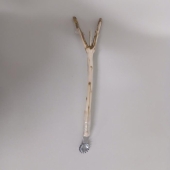Many years ago I read somewhere that trees absorb nutrients from the soil and use them to make leaves and to grow in general. Which is correct. When leaves fall, they are basically returning the nutrients to the soil by breaking down and decomposing. Now a certain amount of gasses (O2, etc.) are liberated to the atmosphere by the decomposition process, but most of the nutrients that the tree absorbed from the ground remains in the leaves.
So to me, burning them is an extremely wasteful way of handling a valuable organic material. I have a lot of trees; various oaks, gum, tupelo, ash, winged elm, and lots of pine.
In August, the pines start shedding their old needles so new ones can grow and replace them. I rake these up covetously for use as mulch for flower beds and under shrubs. I lay it on thick, like 5 or 6" and press it down. After it's rained on several times it settles and makes a very nice mulch that does not break down quickly in our wet winter or hot wet springs and summers. Pine needle mulch looks very nice. It is a natural part of the scenery, and not something alien like that awful red dyed mulch people love to use.
About the time the pines are through shedding, leaves begin to fall so I then have a mixture of leaves and pine needles. Some of it gets used to fill in any gaps in mulching, but a large portion of it gets raked up and moved to the vegetable gardens and tilled under in the fall. Immediately after tilling the leaves under I top plant with winter rye which grows all winter and then in very early spring I till that under too, and then wait a month or so to plant. It seems to be a very successful regime to follow. Some is also spread into low spots in the property to decompose and add organic matter to the ground. And finally some of it gets piled up for slow composting. I don't turn my compost as I am not able to. But piled high it settles out after a few months. After several months the top layer of largely intact leaves and pine needles can be scraped off and lots of crumbly earthy smelling leaf mould can be dug out for use in potted plants, garden areas and flower beds.










